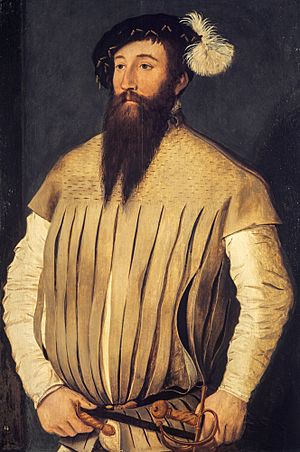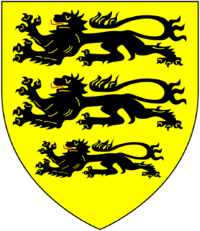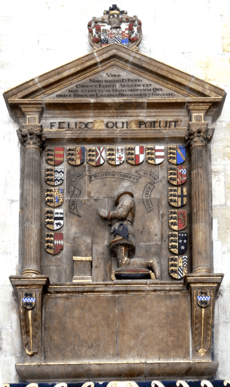Peter Carew facts for kids

Sir Peter Carew (born around 1514 – died 27 November 1575) was an English adventurer from Mohuns Ottery, Luppitt, Devon. He served during the time of Queen Elizabeth I of England. He also played a part in England's efforts to take control of Ireland. His friend and legal helper, John Hooker, wrote a book about his life.
People sometimes call him Sir Peter Carew the elder. This helps to tell him apart from his cousin, also named Sir Peter Carew. His cousin was killed in a battle in 1580.
Contents
Early Life and Adventures
Sir Peter Carew was the third son of Sir William Carew, a gentleman from Devon. He was born in Ottery Mohun, which is now Mohuns Ottery. As a boy, he went to grammar school in Exeter and later St Paul's School. He often skipped school. Once, he climbed a tower on Exeter city wall and threatened to jump! His father then led him home like a dog, on a leash. As a punishment, he was even tied to one of his father's hounds for a while.
Travels and Royal Service
Carew was later sent to work for a French friend of his father. But he was made a mule driver, which was a very low job. Luckily, in 1526, a relative found him. This relative was on his way to a battle called the Siege of Pavia in France. Carew joined him. After his relative died, Carew served a marquis, who also died in battle.
Later, Carew worked for Philibert, Prince of Orange. After the Prince died, Carew was sent to King Henry VIII of England with important letters. The King noticed how good Carew was at riding horses and speaking French. So, King Henry VIII took him into his service.
Fighting in France
In 1540, Carew traveled with his cousin to places like Constantinople, Venice, and Vienna. His cousin died during this trip. Carew then fought in the war against France, both on land and at sea. In 1544, he led a group of soldiers dressed in black, paying for them himself. His brother, George Carew, was in charge of the Mary Rose ship when it sank. Sir Peter Carew also commanded the horse soldiers. For his service in this war, he was made a knight in 1545.
Political Career and Challenges
Sir Peter Carew became a Member of Parliament several times. He represented Tavistock in 1545 and Dartmouth in 1547. He also represented Devon in 1553 and 1559, and Exeter in 1563. In 1547, he served as the High Sheriff of Devon.
In 1549, there was a rebellion in Devon and Cornwall called the Prayer Book Rebellion. This happened because of changes to the church service book. Carew was criticized for how strongly he dealt with the rebels. In 1553, he supported Queen Mary I of England in the west of England. However, later that year, he joined a plot against her marriage to Prince Philip II of Spain. This was part of "Wyatt's Rebellion." Unlike many others, he managed to escape and fled to Europe in 1554.
In 1556, he was arrested in Flanders with Sir John Cheke. He was brought back to England in a fishing boat. He was held in the Tower of London until October 1556. He was released after paying some family debts owed to the Crown.
Service to Queen Elizabeth I
When Elizabeth I became Queen, Carew was sent to help solve a disagreement. This was between Lord Grey and the Earl of Norfolk. They had been leading an army against the French in Scotland. Later, when the Earl of Norfolk was found guilty of treason in 1572, Carew was his jailer. Carew had been made Constable of the Tower.
Adventures in Ireland
In 1568, Sir Peter Carew began his biggest adventure. He claimed he owned large areas of land in the south of Ireland. He had sent old documents to his friend, John Hooker, to examine. Hooker became convinced that the documents proved Carew had a right to these lands. This was because an old English king, Henry II of England, had given land to an ancestor of Carew's.
Claiming Land in Ireland
Queen Elizabeth I allowed Carew to pursue his claims. He sailed to Ireland in August 1568. His first claim was for the lordship of Maston. Carew felt he could not get a fair trial with a jury. So, he went before the lord deputy, Sir Henry Sidney, and his council. The person he was claiming against agreed to a deal.
Next, Carew got a ruling from Sidney and the council for the barony of Idrone. This land was in County Carlow and was held by the Kavanagh family. Carew was also made captain of Leighlin castle, which was in the middle of the barony.
Conflict with the Butler Family
Carew's claims became difficult because they seemed to take land from the powerful Butler family. This was an important Anglo-Norman family in Ireland. Their leader was Sir Thomas Butler, 10th Earl of Ormond. The Earl's younger brother, Edmund, owned Clogrenan castle. This castle had been bought from the Kavanaghs. Edmund Butler was angry about Carew taking land. He believed Carew would try to take his lands too. So, he attacked Carew. Carew fought back and easily took Clogrenan castle.
This land seizure caused a lot of trouble and led to the Butler Wars. These wars then contributed to a bigger uprising called the first Desmond Rebellions.
Plantation Plans and Rebellion
Carew fought well against the Butlers. But their power was too great for his efforts. He wanted more than just inherited lands in Ireland. He also had a plan to settle English people there. In 1569, the Queen's council in London approved his idea. He, along with others, wanted to take lands in Baltimore, Munster. They planned to do this by finding problems with land titles, removing rebels, and bringing in English settlers. Carew's legal helper, John Hooker, had become an important English member of the Parliament of Ireland in Dublin.
The first Desmond Rebellion (1569–1573) began. Rebels fought fiercely along the coast of Munster. They attacked cities like Cork. They demanded that all efforts to settle English people stop. Both sides destroyed the countryside. It became clear that Carew had gone too far. The Earl of Ormond managed to get his followers to stop rebelling against the Crown. After the Earl returned to court, the Queen decided to call Carew back to England.
Carew returned to Ireland in 1574. He had refused the Queen's request to take his seat in parliament again. He found that some Irish lords and families were willing to accept his claims and rent land from him. Once this part of his plan was settled, he ordered a house to be ready for him in Cork. But he became ill and died on the way, on 27 November 1575, in Ross, County Waterford.
Legacy and Memorials
Sir Peter Carew was buried in Waterford Cathedral. The cathedral was rebuilt later, so his grave is no longer there. However, there is a monument to him on a wall in Exeter Cathedral. His friend John Hooker put it there. It was moved to a different part of the cathedral in 1805.
Sir Peter Carew did not have any children. His will was dated July 4, 1574. His cousins, Peter (who died in 1580) and George (1555–1629), became his heirs. George later became the 1st Earl of Totnes.
Two paintings of him by Gerlach Flicke still exist today. One is at Hampton Court Palace in the Royal Collection. The other is in the Scottish National Gallery.
Books About Sir Peter Carew
By John Hooker
Sir Peter Carew's life story was written by his friend and legal helper, John Hooker. Hooker wrote it soon after Carew died. This was very early for a book about a normal person who wasn't a king or queen. It is seen as an important early English biography. The original handwritten book is kept at Lambeth Palace Library.
Different Versions
Hooker's book has been published three times:
- "The Life of Sir Peter Carew, of Mohun Ottery, co. Devon," edited by Sir Thomas Phillipps, published in 1840.
- "The Life and Times of Sir Peter Carew," edited by John Maclean, published in 1857. This version includes a lot more information.
- In the "Calendar of the Carew Manuscripts," edited by J. S. Brewer and William Buller, published in 1867.
By John Wagner
There is also a modern, full-length book about Sir Peter Carew written by John Wagner in 1998.



